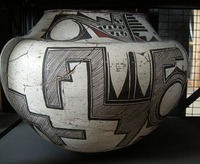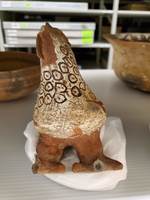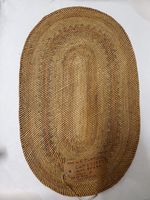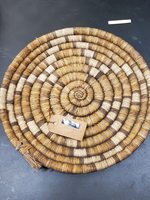More Information
How Did the Smithsonian Get Here?
The Lafayette College collection of Indigenous Art is largely composed of objects transferred from the Smithsonian in the 1920s. These objects are reflective of the Smithsonian’s early history and collecting practices and arrived at the college as part of a museum program to transfer duplicate objects. To understand the power of these objects in shaping collections and knowledge at both the Smithsonian and at Lafayette College, we must first understand the Smithsonian’s collecting practices and motivations in purchasing, transporting, and caring for these particular pieces.
The second Secretary of the Smithsonian, Spencer F. Baird, encouraged the development of large, systematic collections at the institution. Beginning in 1875, Baird and geologist John Wesley Powell organized collectors, asking them to focus on objects that illustrated the daily lives of contemporary Native Americans as well as older items that showed the supposed “progress” of assimilation. Bureau of Indian Affairs agents haphazardly collected objects of personal interest for the growing museum. These objects arrived in the collection little provenance, or contextual documentation, so they had little scientific value for researchers, who could not pinpoint when or where a particular object was collected.[1]
In 1879, the Bureau of Ethnology was established as the professional collecting division of the Smithsonian Institution, to more systematically collect objects and their supporting documentation from areas that were of interest to the Smithsonian. This move allowed the existing Anthropology Department of the U.S. National Museum to focus on the care and interpretation of collections, rather than their acquisition. This collecting branch would later become the Bureau of American Ethnology in 1894. The first expedition sponsored by the new Bureau was in 1879, when the ethnographers James Stevenson, Matilda Coxe Stevenson, and Frank Hamilton Cushing traveled to the Southwest with photographer John Hillers. Their destination had been specifically selected for its density of Indigenous cultures, which would allow the researchers to efficiently build up knowledge and collections for their home institution. On this and following expeditions, the Stevensons, Cushing, and the Mindeleff brothers (architects who joined later expeditions) collected thousands of objects, including vast collections of pottery created by the Pueblo tribes of New Mexico and Arizona.[2]
With such a large influx of material from collecting expeditions, the Smithsonian eventually determined that the best course of action was to redistribute “duplicate specimens” to other educational institutions. As objects were cataloged and brought into storage, each piece was identified as a specimen of a specific type – for example, a jar with a rainbird design from Zuni. Any subsequent jars with the same design and origin would then be considered duplicates, rather than artistic originals as we now see them. The Smithsonian would then consider alternative homes for the duplicates, gifting or trading them to other cultural institutions. It was believed that this process of transferring objects to museums, schools, and libraries would encourage the advancement of scientific knowledge in the areas of interest to the Smithsonian while building a network of museum professionals and easing pressure on the Smithsonian’s limited storage options.[3]
Scholars such as Catherine A. Nichols have argued that this distribution earned the Smithsonian prestige, placing it in the realm of international research institutions, while using objects as pawns without regard for their individuality and potential to support the Smithsonian’s own collections.[4] For example, the Lafayette Collection includes a ceramic bowl collected at Acoma by the Stevensons and accessioned by the Smithsonian in 1884. Because the museum already owned Acoma bowls with similar geometric, triangular designs, they deemed this one a duplicate and gifted it to Lafayette. This transfer is noted in red pen in the Smithsonian’s original ledger-style records, next to an illustration of the bowl and the others that were collected with it. However, current scholarship would argue that no two handmade Acoma bowls are exactly alike, and a collection with multiple triangular designs could provide scholars with information about how the design changed over time and between individual artists. This is because current scholarship views these bowls as individual artworks, each reflective of their maker, while the Smithsonian in the 1920s considered them to be specimens of Acoma culture, teaching overarching ideas of Acoma culture.
Once at Lafayette, the bowl was used for teaching about Indigenous cultures, displayed with other pottery and baskets transferred from the Smithsonian and with Neolithic stone tools collected when Lafayette was a mining college. These two educational collections, of Smithsonian specimens and stone tools, were exhibited together, in what was probably an attempt to show a progression of Indigenous culture. They were then stored in a remote area of the college with limited access until their recent move to the Kirby Collections Storage Area, where they can now be studied by students and faculty. A century after these objects were transferred from the Smithsonian, they are once again sparking interest in Indigenous culture and life, just as the Institution intended.
[1] Nancy J. Parezo, “The Formation of Ethnographic Collections: The Smithsonian Institution in the American Southwest,” Advances in Archaeological Method and Theory 10, no. 1987 (1987): 1–47.
[2] Ibid.
[3] Catherine A. Nichols, “Shared Values, Gifted Objects: The Smithsonian Institution’s Anthropological Duplicates,” Collaborative Anthropologies 7, no. 2 (2015): 32–71.
[4] Ibid., 35.
How Did This Damage Get Here?
The objects in the Lafayette College collection of Indigenous Art were transferred from the Smithsonian Institute in the 1920s. Once they arrived at Lafayette College, these objects were initially used for teaching but then stored for future use. Unfortunately, they were packed for storage by people who did not understand the unique needs of these objects, and some damage occurred as a result. Pottery broke, baskets faded, and arsenic contaminations went undocumented. With the opening of the Kirby collections storage area, the Indigenous art objects were moved to a new home, where they are kept in regulated light and humidity conditions, safe from further damage and better accessible to students for study.
The damage done to the pottery in this collection was perhaps inevitable; ceramics are inherently fragile, and the thin-walled pottery in our collection is especially so. When the Stevensons and other ethnographic explorers collected works of Pueblo pottery by the thousands, many acquisitions broke on the long journey back to the East coast. In his essay about the work of the Nahohai, a Zuni family of potters, art historian Edward Chappell recounts a story of George Coleman. In 1920, Coleman traveled to the Southwest and bought three large jars, which he packed for his return home to Virginia. Upon arrival, he realized that all three of his purchases had broken en route, but he nevertheless displayed them, carefully pieced back together, as emblems of his journey.[1] Pueblo pottery, even when broken, communicates much about the southwest cultures who created it and the individuals who collected it.
After collection in the Southwest and transportation across the country, the surviving pieces of pottery collected by ethnographic explorers for the Smithsonian often broke in handling within their new museum homes. A ceramic chicken from Zuni, New Mexico, was collected by the Stevensons. At some point during its travels, it lost a toe, revealing the dark core of the ceramic. We do not know when the ceramic broke – either in the Smithsonian’s collections or at Lafayette. What we do know is that the breakage is revealing. The dark carbon core revealed by the missing toe is created by the inclusion of ground potsherds as temper in the clay, used by Zuni potters to make their clay more workable since about 1300 CE. [2] In this chicken, the missing toe is both evidence of cross-country travels and a window into the material results of a centuries-old pottery tradition, proof that sometimes, damaged works can be more enlightening than their pristine counterparts.
The Lafayette collection of Indigenous art also includes several baskets from a variety of cultures. Large Pomo baskets were used for carrying peaches and other fruit, while thinner baskets from the Sklingit River were used for carrying clothing and personal belongings. Many of these baskets stiffened in the dry air of their storage room and are now unusable. Some of the bright, bold designs of the baskets faded until they were nearly unrecognizable. One mat, woven by an Indigenous woman in Alaska, displays vibrant blues and reds on one side, faded to shades of tan on the other. The fading is likely the result of its storage near a window, where incoming sunlight broke down the dyed colors in the plant matter. However, we can use this fading to ask questions of Indigenous uses of similar baskets. Would baskets and mats used in Indigenous homes have faded in the same ways? Would an Indigenous user flip the mat to even the fading, or would they allow one side to fade more than the other, like the Lafayette example? Are certain dyes more likely to fade, and do artists think about fading when selecting dyes? Despite the damage to the Lafayette mat, its presence and flaws raise questions for researchers to uncover through close study of this and other objects.
As the objects, including pottery, basketry, and other items, were moved from their previous storage area to the Kirby collections storage, they were tested for contamination with the use of an XRF handgun. Several pieces in the collection were found to be contaminated with arsenic, a heavy metal that is toxic to humans. Because arsenic is also toxic to pests, it was used in museums like the Smithsonian in the twentieth-century as a preservative, to stop insects and rodents from chewing on organic materials like the woven plants in basketry. Arsenic is not the only contaminant of concern in this collection - one coiled basket did not reveal any arsenic contamination but is labeled “poisoned,” probably meaning that it was treated with mercury chloride while in the Smithsonian collection. Mercury chloride was used as an alternative to arsenic in pest control, but it is also toxic to humans.
This Haida hat tested positive for arsenic contamination, meaning that future researchers must use disposable gloves and exercise caution when handling it. Poison contamination poses a problem to repatriation efforts, as any effort to return an object like this to its source community must now consider the community’s ability to protect themselves from the arsenic as they handle and use it. Recently, scholars have explored ways to remove arsenic and other contaminants from objects like these, but there are currently no perfect solutions. So, just as the damage to our collections can reveal information about the way it was made or questions about the culture that made it, the contamination of these items has raised new avenues for research as we work to return objects to communities in the safest ways possible.
[1] Edward A. Chappell, “Pride Flared Up: Zuni (A:Shiwi) Pottery and the Nahohai Family,” Ceramics in America, 2015.
[2] Dwight P. Lanmon and Francis H. Harlow, The Pottery of Zuni Pueblo (Santa Fe: Museum of New Mexico Press, 2008), 56.



